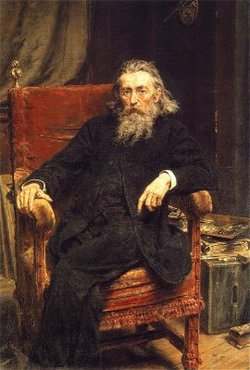Prominent Poles
Jan Matejko, painter

Born: June 24, 1838, Cracow, Austrian partition of Poland (presently Poland)
Died: November 1, 1893, Cracow, Poland
Early days. His Czech father, Franciszek Ksawery Matejko, was a tutor and music teacher. He worked first for the Wodzicki family in Koscielniki, then moved to Cracow where he married Joanna Karolina Rossberg from a Polish-German family of a well to do saddler. Jan was the 9th child from11 that his parents had. After the death of his mother in 1846 Matejko and his siblings were taken care of by his aunt Anna Zamojska. From earliest days he showed exceptional artistic talent that let him advance from grade to grade as he had great difficulties with other subjects. He never mastered a foreign language and didn't do well even with Polish. That's why any public appearances to which he was forced all his life were for him real nightmares. He attended St.Anna high school which he dropped in 1851 because of poor results.
Studies. From 1852 to 1858 he studied at the School of Fine Arts in Cracow under W.K.Stattler and W. Luszczkiewicz. During this time he started exhibiting historical paintings with the Society of Friends of the Fine Arts there (e.g. Sigismund I Bestowing Nobility on the Professors of the University of Kraków in 1535.). After studying in Munich (1859) under the history painter H. Anschütz (where he got a bronze medal for a study of male act) and then briefly and less successfully in Vienna, Matejko returned to Cracow, where he lived for the rest of his life and where, beginning in 1873, he was for many years the principal of the School of Fine Arts.
Marriage, work. In 1864 he married Teodora Giebultowska. They had four children: Beata, Helena, Tadeusz and Jerzy.
Jan Matejko witnessed in 1848 bombing of Cracow by the Austrians and also the January Rising of 1863 in which he did not participate because of poor health (but he supported it financially and he transported arms to the insurgents' camp in Goszcza).
In 1860 Matejko issued an illustrated album, Ubiory w Polsce ,a project reflecting his intense interest in historical records of all kinds and his desire to promote such interest among the Polish people in an effort to intensify their patriotic feelings. In 1861 he had an exhibition "Otrucie królowej Bony" in Warsaw's Zacheta. The national defeats forced him to abandon the religious painting which, he believed, was his vocation and to devote himself almost exclusively to historical painting. In fact he created a vision of Polish history from which we can not liberate ourselves despite of perennial criticism of the scientists. Matejko often placed on his paintings people who were not present at this location (f.ex. Kollataj, and General Wodzicki, on "The Raclawice Battle"). He was not interested in presenting factual events but in representation of a historical-philosophical synthesis. In 1864 he became a member of Scientific Society in Cracow.
Matejko was focusing on major themes in Polish history and using historical sources to paint events in minute historical detail. He created two groups of historical paintings. The earlier one starting with the painting Stanczyk (1862) was directed against the magnates whose lack of patriotism caused, in his opinion, the fall of Poland. Stanczyk, the court jester to King Sigismund I (1437-1548), to whom Matejko gave his own features. The jester is presented as a symbol of the nation's conscience: he sits glumly in a chair apart from the other figures, alone in seeing that events during the wars against Moscow would ultimately end in tragedy. This group of paintings included among others also Kazanie Skargi (1864) and Reytan (1866).
The second group, painted after the defeat of January Rising, is dedicated to famous events in Polish history. Matejko depicted every major event or battle in Polish history. His most famous work is Bitwa pod Grunwaldem (1878) depicting the 1410 Battle of Grunwald which garnered him international acclaim. Other paintings in this group include Unia Lubelska (1869), Stefan Batory pod Pskowem (1872), Kopernik, Dzwon Zygmunta (1874), Hołd Pruski (1882), Sobieski pod Wiedniem (1883), Wernyhora, Kościuszko pod Racławicami (1888), Dzieje Cywilizacji w Polsce (1889) and Konstytucja 3 Maja (1891). From 1890 to 1892 he also painted all of the Polish kings compiled in his book Portraits of Polish Kings (1890); his dedication to detail is evident in that he attended the opening of Queen Jawiga's sarcophagus in 1887 to make sketches of her skull.
In addition to historical events Matejko made also several portraits. Among others: Żona w sukni ślubmej (1879), A. Potocki (1879), S. Tarnowski (1890), Autoportret (1892).
Altogether Matejko authored 320 oil paintings and several thousands drawings and watercolors. Finally he painted a monumental polychrome in Maria's Church in Cracow (1889-1891). His most important paintings were hidden during WWI (Bitwa pod Grunwaldem was buried in Lublin). After 1945 majority of his works was found and subject to restauration. They are now mainly in Warsaw's National Museum (Muzeum Narodowe).
His more prominent students:
Maurycy Gottlieb, Jacek Malczewski, Józef Mehoffer, Witold Pruszkowski, Leon Wyczólkowski, Stanislaw Wyspianski.
Matejko died on November 1, 1893 and was buried in the middle of the Alley of the Meritorious at Cracow's Rakowicki Cemetery.
Source:
This article uses, among others, material from the Wikipedia article "Jan Matejko" licensed under the GNU Free Documentation License. :
Wikipedia (in Polish)
Other sources:
Artyzm (in Polish)
Historia Ziemi Bochenskiej (in Polish)
Witold Raczunas (in Polish)
The above site includes very good reproductions of many of Matejsko's paintings.
Grove Dictionary of Art
Return to home page:
Prominent Poles
